Python
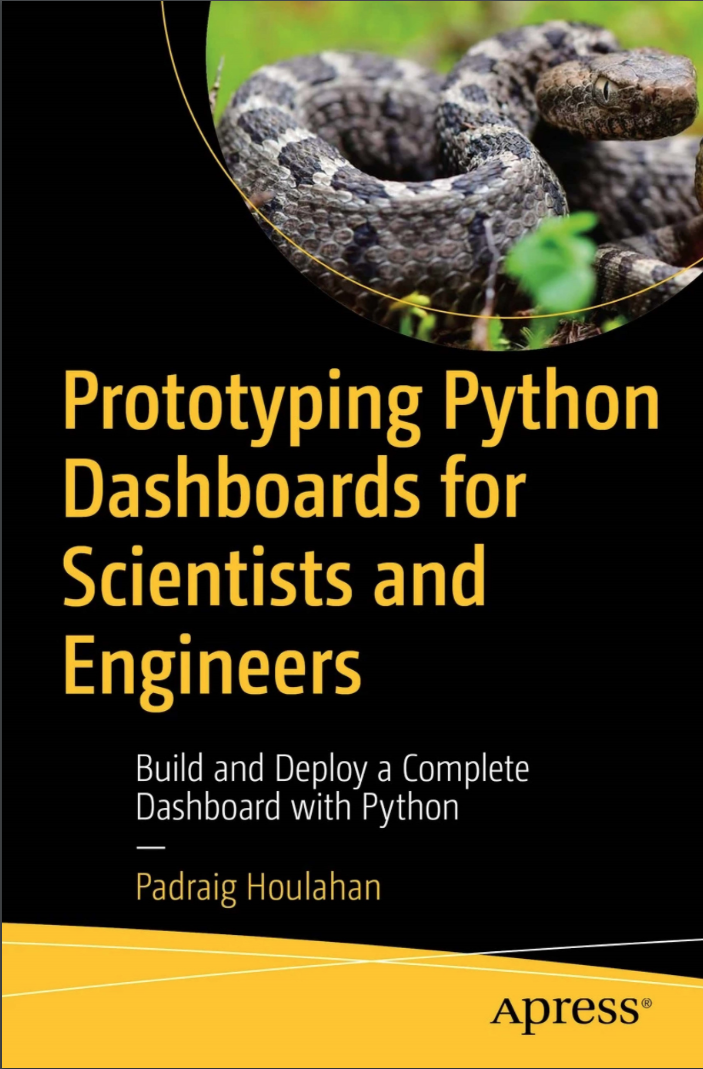
Prototyping Python Dashboards for Scientists and Engineers - Padraig Houlahan
Create interactive and data-driven dashboards using Python. This hands-on guide is a practical resource for those (with modest programming skills) in scientific and engineering fields looking to leverage Python's power for data visualization and analysis in a user-friendly dashboard format.
You’ll begin by gaining a fundamental understanding of Python programming, including data types, lists, dictionaries, and data structures. The book then delves into the world of reactive programming with Plotly and Dash, offering a hands-on approach to building interactive web-based dashboards. Next, you’ll see how to work with online data, how to scrape and clean datasets, and keep files up-to-date.
The book also guides you through planning a dashboard prototype, outlining project tasks, trends, forecasts, spectra, and other design considerations. It concludes with a discussion of how the dashboard can be used for data visualization of real data, explaining the usefulness of tools such as spectra.
By providing detailed examples for download and customization, Prototyping Python Dashboards for Scientists and Engineers will equip you with the skills needed to jumpstart your own development efforts.
What You’ll Learn
- Design a dashboard with Python
- Convert and filter Excel formatted files to produce CSV files
- Create browser-served graphics with PLOTLY
- Generate polynomial trend lines for forecasting
- Build a Unix service to share your dashboard
Who This Book Is For
Scientists, engineers, students, programmers, and data enthusiasts who aspire to harness Python's potential for data visualization and analysis through the creation of interactive dashboards. Many will be pragmatic programmers with modest skills and limited resources who mainly want to see a working solution they could emulate.
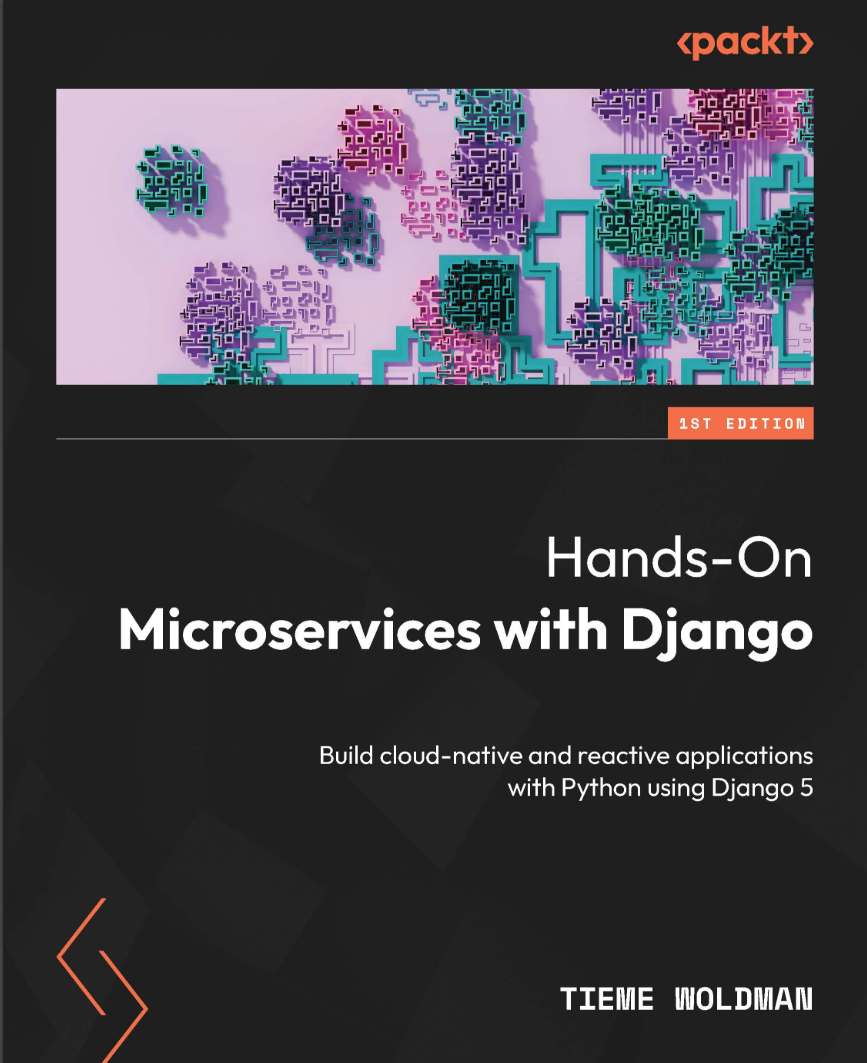
Hands-On Microservices with Django - Tieme Woldman
Are you a Django developer looking to leverage microservices to create optimized and scalable web applications? If yes, then this book is for you. With microservices, you can split an application into self-contained services, each with a specific scope running asynchronously while collectively executing processes. Written by an experienced Python developer, Hands-On Microservices with Django teaches you how to develop and deploy microservices using Django and accompanying components such as Celery and Redis. You'll start by learning the principles of microservices and message/task queues and how to design them effectively. Next, you’ll focus on building your first microservices with Django RESTful APIs (DFR) and RabbitMQ, mastering the fundamentals along the way. As you progress, you’ll get to grips with dockerizing your microservices. Later, you’ll discover how to optimize and secure them for production environments. By the end of this book, you’ll have the skills you need to design and develop production-ready Django microservices applications with DFR, Celery/RabbitMQ, Redis, and Django's cache framework.
What you will learn
Understand the architecture of microservices and how Django implements it Build microservices that leverage community-standard components such as Celery, RabbitMQ, and Redis Test microservices and deploy them with Docker Enhance the security of your microservices for production readiness Boost microservice performance through caching Implement best practices to design and deploy high-performing microservices
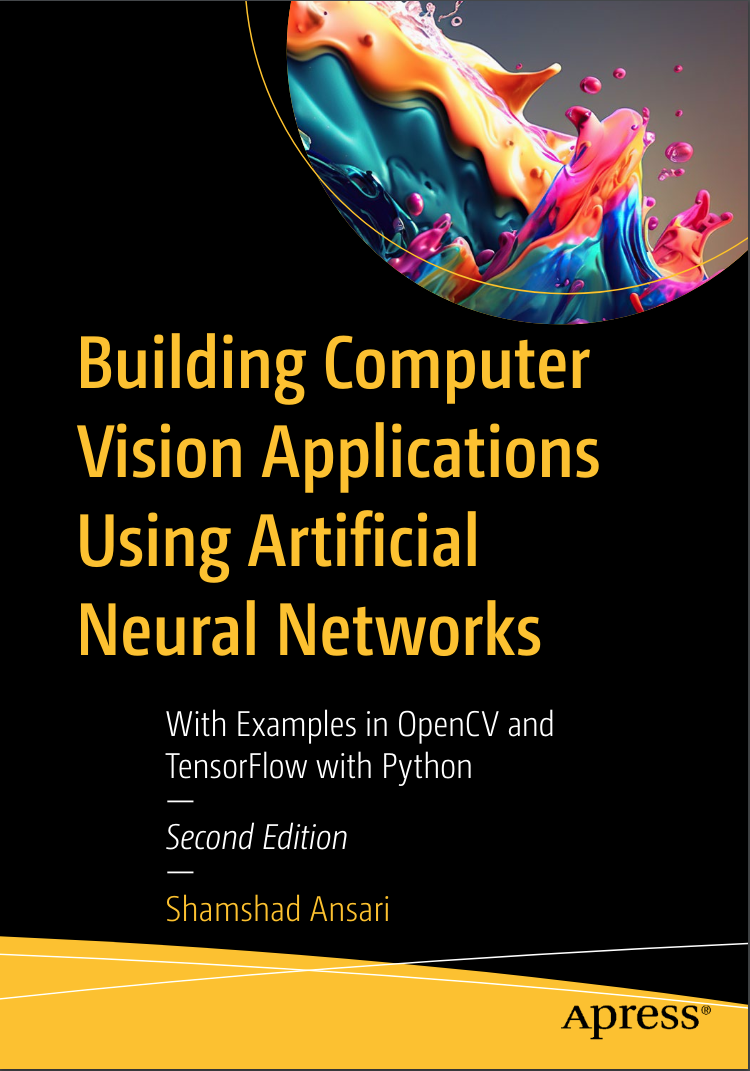
Building Computer Vision Applications Using ANNs. 2 Ed - Shamshad Ansari
Computer vision is constantly evolving, and this book has been updated to reflect new topics that have emerged in the field since the first edition’s publication. All code used in the book has also been fully updated.
This second edition features new material covering image manipulation practices, image segmentation, feature extraction, and object identification using real-life scenarios to help reinforce each concept. These topics are essential for building advanced computer vision applications, and you’ll gain a thorough understanding of them. The book’s source code has been updated from TensorFlow 1.x to 2.x, and includes step-by-step examples using both OpenCV and TensorFlow with Python.
Upon completing this book, you’ll have the knowledge and skills to build your own computer vision applications using neural networks
What You Will Learn
- Understand image processing, manipulation techniques, and feature extractionmethods
- Work with convolutional neural networks (CNN), single-shot detector (SSD), and YOLO
- Utilize large scale model development and cloud infrastructure deployment
- Gain an overview of FaceNet neural network architecture and develop a facial recognition system
Who This Book Is For
Those who possess a solid understanding of Python programming and wish to gain an understanding of computer vision and machine learning. It will prove beneficial to data scientists, deep learning experts, and students.
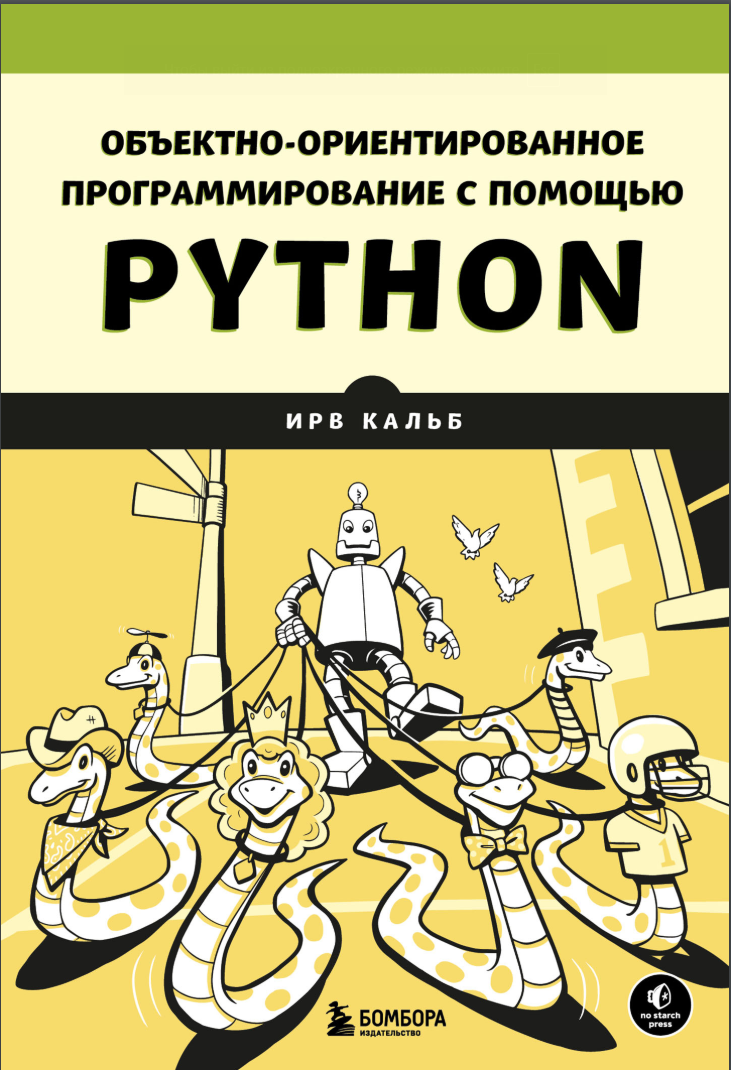
Объектно-ориентированное программирование с помощью Python - Ирв Кальб
Объектно-ориентированное программирование (ООП) — это метод, основанный на представлении программы в виде совокупности объектов, каждый из которых является экземпляром определенного класса, а классы образуют иерархию наследования, что позволяет по-другому думать о вычислительных задачах и решать их с возможностью многократного использования.
«Объектно-ориентированное программирование с помощью Python» предназначено для программистов среднего уровня и представляет собой практическое руководство, которое глубоко изучает основные принципы ООП и показывает, как использовать инкапсуляцию, полиморфизм и наследование для написания игр и приложений с использованием Python.
Книга начинается с рассказа о ключевых проблемах, присущих процедурному программированию, затем вы познакомитесь с основами создания классов и объектов в Python.
Затем вы научитесь создавать графические интерфейсы c помощью pygame, благодаря чему вы сможете писать интерактивные игры и приложения с виджетами графического пользовательского интерфейса (GUI), анимацией, различными сценами и многоразовой игровой логикой.
В итоге у вас получится полнофункциональная видеоигра, включающая в себя многие методы ООП и элементы графического пользовательского интерфейса, описанные в книге.
Вы узнаете, как:
- Создавать несколько объектов и управлять ими с помощью объекта диспетчера объектов.
- Научитесь использовать инкапсуляцию, чтобы скрыть внутренние детали объектов от клиентского кода.
- Научитесь использовать полиморфизм для определения одного интерфейса и реализации его в нескольких классах.
- Сможете применять наследование для использования существующего кода.
«Объектно-ориентированное программирование с помощью Python» — это визуальное, интуитивно понятное руководство, позволяющее полностью понять, как работает ООП и как с его помощью сделать свой код более удобным в сопровождении, читаемым и эффективным, не жертвуя при этом функциональностью.
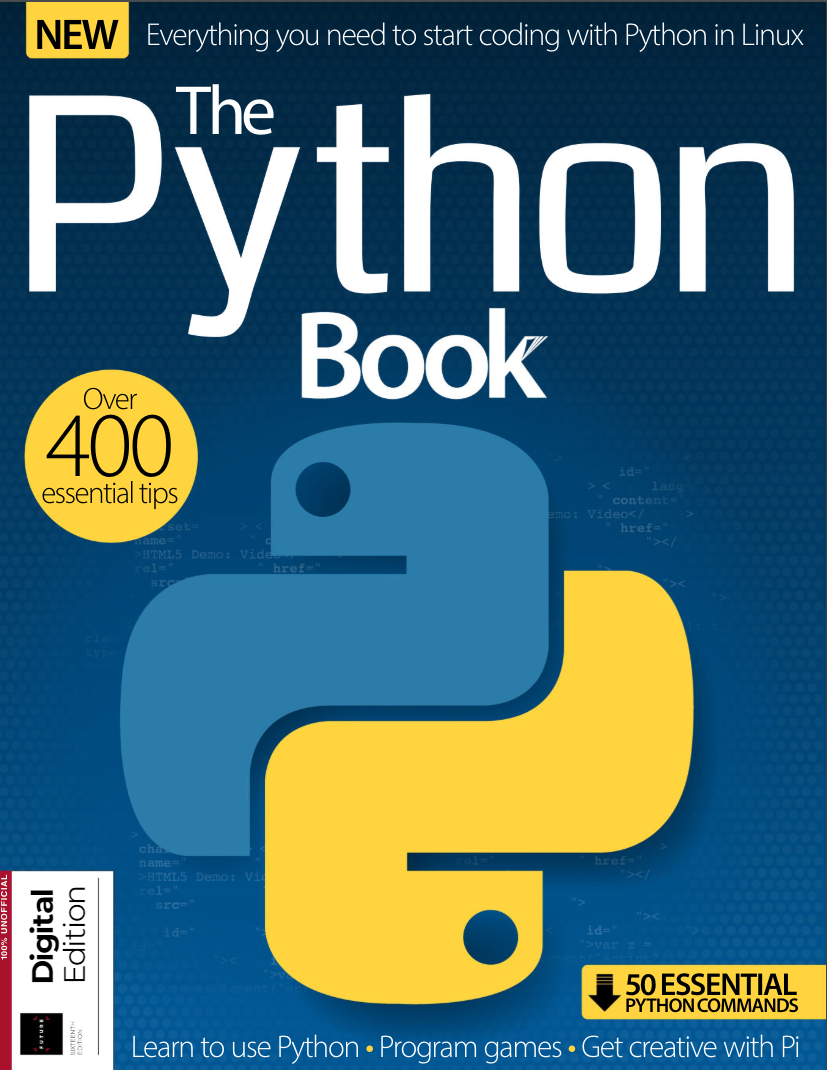
The Python book.16 Ed - April Madden
Python is an incredibly versatile, expansive language that, due to its similarity to everyday language, is surprisingly easy to learn even for inexperienced programmers. It has seen a huge increase in popularity since the release and rise of the Raspberry Pi, for which Python is the officially recognised programming language. In this new edition of The Python Book, you’ll find plenty of creative projects to help you get to grips with the combination of your Raspberry Pi and Python’s powerful functionality, plus lots of tutorials that focus on Python’s effectiveness away from the tiny computer. You’ll learn all about how to code with Python from a standing start with our comprehensive masterclass, then go on to complete tutorials that will consolidate your skills and help you become fluent in the language. You’ll learn how to make Python work for you with tutorials on coding with Django, Flask, Pygame and even more useful third-party frameworks. Get ready to become a true Python expert with the wealth of information contained within these pages .

Решение трудных и увлекательных задач на Python - Рашид Бехзадидуст, Хабиб Изадха
Цель данной книги – укрепить навыки логического рассуждения и развить творческое мышление, представив и решив 90 не самых простых задач на Python. Задачи изложены доходчиво и сжато, снабжены с алгоритмами и комментариями, что помогает читателям следить за процессом их решения и понимать его суть.
Издание предназначено читателям с базовыми знаниями языка Python, которые стремятся вывести свои способности на новый уровень. Книга будет полезна студентам, преподавателям, разработчикам, а также участникам соревнований по программированию.
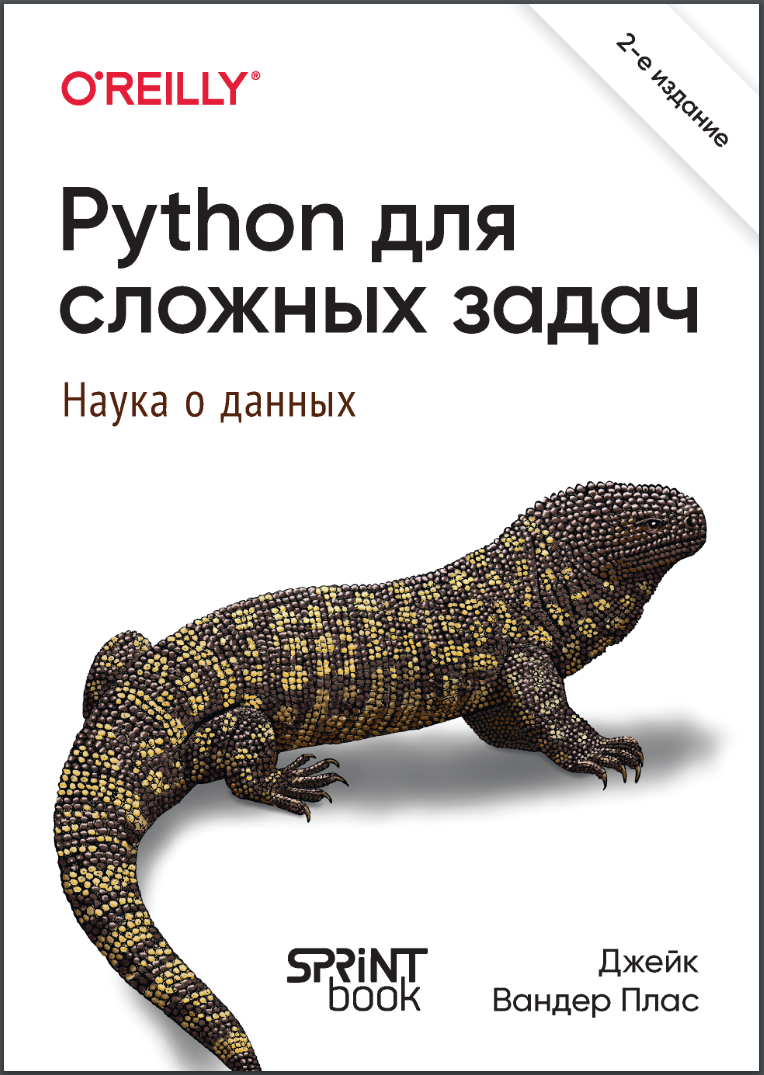
Python для сложных задач. Наука о данных. 2 изд. - Джейк Вандер Плас
2-е международное издание.
Python — первоклассный инструмент, и в первую очередь благодаря наличию множества библиотек для хранения, анализа и обработки данных. Отдельные части стека Python описываются во многих источниках, но только в новом издании «Python для сложных задач» вы найдете подробное описание: IPython, NumPy, pandas, Matplotlib, Scikit-Learn и др.
Специалисты по обработке данных, знакомые с языком Python, найдут во втором издании решения таких повседневных задач, как обработка, преобразование и подготовка данных, визуализация различных типов данных, использование данных для построения статистических моделей и моделей машинного обучения. Проще говоря, эта книга является идеальным справочником по научным вычислениям в Python.
5 причин прочитать:
- IPython и Jupyter — это идеальная вычислительная среда для специалистов, использующих Python.
- Класс DataFrame для эффективного хранения и обработки маркированных/табличных данных.
- ndarray для эффективного хранения плотных массивов данных и управления ими.
- Matplotlib и гибкие средства визуализации данных.
- Scikit-Learn для эффективной реализации на Python наиболее важных и хорошо зарекомендовавших себя алгоритмов машинного обучения.
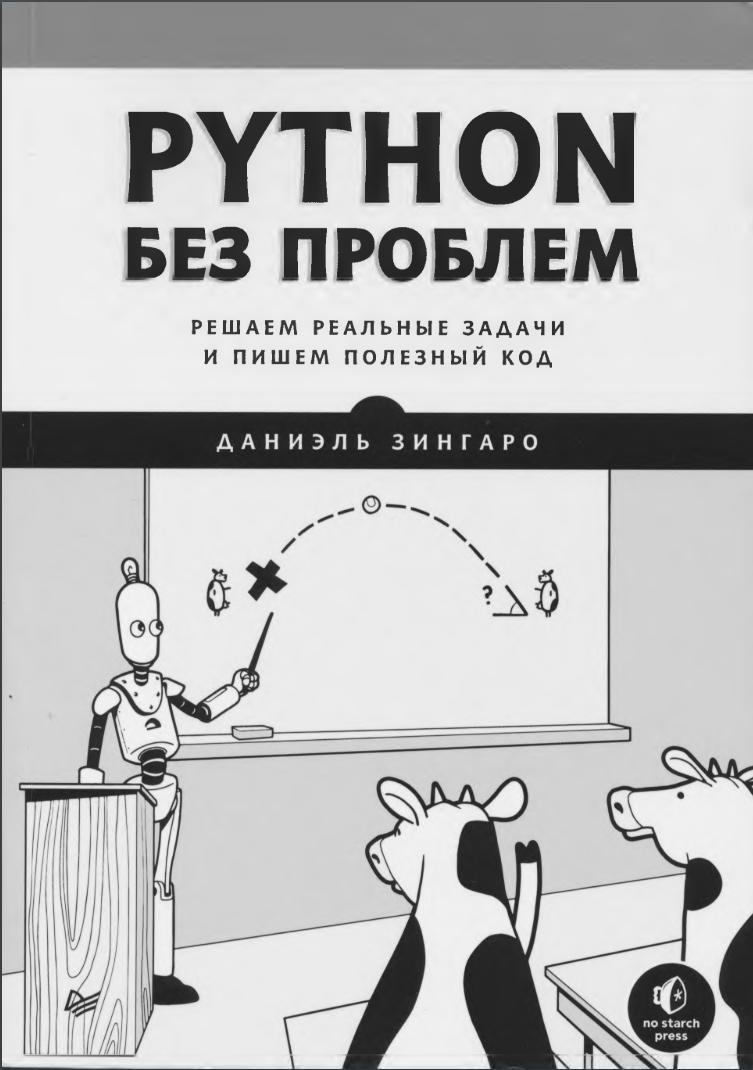
Python без проблем. Решаем реальные задачи и пишем полезный код - Даниэль Зингаро
Компьютер способен решить практически любую задачу, если ему дать правильные инструкции. С этого и начинается программирование. Даниэль Зингаро создал книгу для начинающих, чтобы вы сразу учились решать интересные задачи, которые использовались на олимпиадах по программированию, и развивали мышление программиста.
В каждой главе вам даются задания, собственные решения можно выложить на сайт и получить оценку профи. Вы на практике освоите основные возможности, функции и методы языка Python и получите четкое представление о структурах данных, алгоритмах и других основах программирования. Дополнительные упражнения потребуют от вас усилий, вы должны будете самостоятельно изучить новые понятия, а вопросы с несколькими вариантами ответов заставят задуматься об особенностях работы каждого фрагмента кода.
Вы узнаете, как:
- запускать программы на Python, работать со строками и использовать переменные;
- писать программы, принимающие решения;
- повысить эффективность кода с помощью циклов while и for;
- использовать множества, списки и словари для организации, сортировки и поиска данных;
- разрабатывать программы с использованием функций и методики нисходящего проектирования;
- создавать алгоритмы поиска и использовать нотацию «О большое» для разработки более эффективного кода.
К концу книги вы не только овладеете Python, но и научитесь тому типу мышления, который необходим для решения задач. Языки программирования приходят и уходят, а подходы к решению проблем останутся с вами навсегда!
Комментарий
К концу книги вы не только овладеете Python, но и научитесь тому типу мышления, который необходим для решения задач. Языки программирования приходят и уходят, а подходы к решению проблем останутся с вами навсегда!

Speed Up Your Python with Rust - Maxwell Flitton
Python has made software development easier, but it falls short in several areas including memory management that lead to poor performance and security. Rust, on the other hand, provides memory safety without using a garbage collector, which means that with its low memory footprint, you can build high-performant and secure apps relatively easily. However, rewriting everything in Rust can be expensive and risky as there might not be package support in Rust for the problem being solved. This is where Python bindings and pip come in.
This book will help you, as a Python developer, to start using Rust in your Python projects without having to manage a separate Rust server or application. Seeing as you'll already understand concepts like functions and loops, this book covers the quirks of Rust such as memory management to code Rust in a productive and structured manner. You'll explore the PyO3 crate to fuse Rust code with Python, learn how to package your fused Rust code in a pip package, and then deploy a Python Flask application in Docker that uses a private Rust pip module. Finally, you'll get to grips with advanced Rust binding topics such as inspecting Python objects and modules in Rust.
By the end of this Rust book, you'll be able to develop safe and high-performant applications with better concurrency support.
What You Will Learn
- Explore the quirks of the Rust programming language that a Python developer needs to understand to code in Rust
- Understand the trade-offs for multiprocessing and thread safety to write concurrent code
- Build and manage a software project with cargo and crates
- Fuse Rust code with Python so that Python can import and run Rust code
- Deploy a Python Flask application in Docker that utilizes a private Rust pip module
- Inspect and create your own Python objects in Rust
Who this book is for:
This book is for Python developers who want to speed up their Python code with Rust and implement Rust in a Python system without altering the entire system. You'll be able to learn about all topics relating to Rust programming. Basic knowledge of Python is required to get the most out of this book.
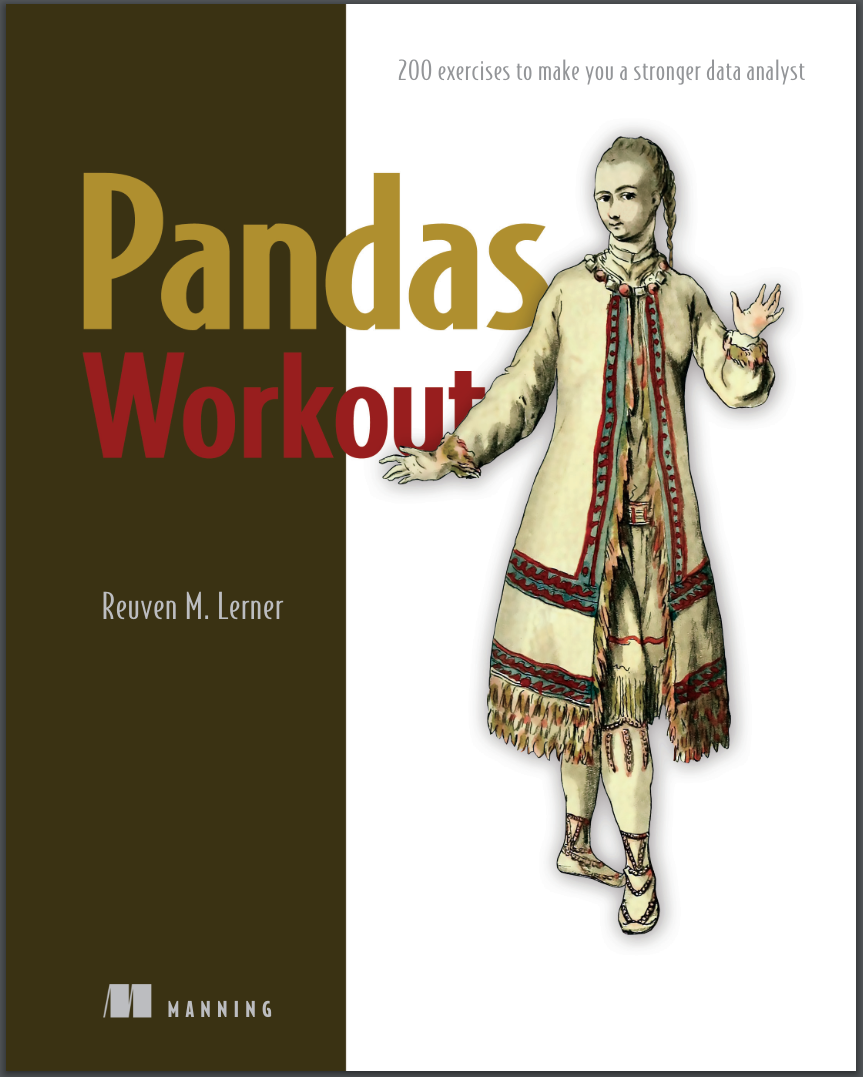
Pandas Workout - Reuven M. Lerner
Practice makes perfect pandas!
Work out your pandas skills against dozens of real-world challenges, each carefully designed to build an intuitive knowledge of essential pandas tasks.
In Pandas Workout you’ll learn how to:
- Clean your data for accurate analysis
- Work with rows and columns for retrieving and assigning data
- Handle indexes, including hierarchical indexes
- Read and write data with a number of common formats, such as CSV and JSON
- Process and manipulate textual data from within pandas
- Work with dates and times in pandas
- Perform aggregate calculations on selected subsets of data
- Produce attractive and useful visualizations that make your data come alive
Pandas Workout hones your pandas skills to a professional-level through two hundred exercises, each designed to strengthen your pandas skills. You’ll test your abilities against common pandas challenges such as importing and exporting, data cleaning, visualization, and performance optimization. Each exercise utilizes a real-world scenario based on real-world data, from tracking the parking tickets in New York City, to working out which country makes the best wines. You’ll soon find your pandas skills becoming second nature—no more trips to StackOverflow for what is now a natural part of your skillset.
Purchase of the print book includes a free eBook in PDF, Kindle, and ePub formats from Manning Publications.
About the technology
Python’s pandas library can massively reduce the time you spend analyzing, cleaning, exploring, and manipulating data. And the only path to pandas mastery is practice, practice, and, you guessed it, more practice. In this book, Python guru Reuven Lerner is your personal trainer and guide through over 200 exercises guaranteed to boost your pandas skills.
About the book
Pandas Workout is a thoughtful collection of practice problems, challenges, and mini-projects designed to build your data analysis skills using Python and pandas. The workouts use realistic data from many sources: the New York taxi fleet, Olympic athletes, SAT scores, oil prices, and more. Each can be completed in ten minutes or less. You’ll explore pandas’ rich functionality for string and date/time handling, complex indexing, and visualization, along with practical tips for every stage of a data analysis project.
What's inside
- Clean data with less manual labor
- Retrieving and assigning data
- Process and manipulate text
- Calculations on selected data subsets
About the reader
For Python programmers and data analysts.
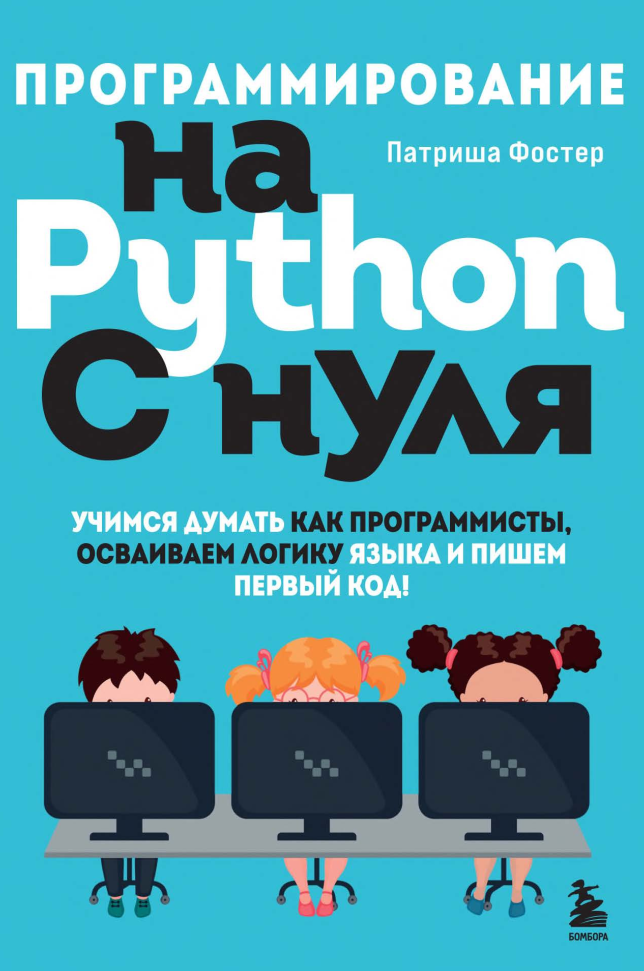
Программирование на Python с нуля : учимся думать как программисты - Фостер Патриша
«Программирование на Python с нуля» — это идеальная книга для тех, кто хочет познакомиться с основами одного из самых популярных языков программирования. С её помощью вы отправитесь в увлекательное путешествие от первых строк кода до создания полноценной игры.
В книге вы не только изучите ключевые элементы Python, но и попрактикуетесь в их использовании благодаря практическим упражнениям от автора. По мере чтения задачи будут становиться всё сложнее и интереснее.
К концу книги вы сможете не только создать свою первую научно-фантастическую игру, но и расшифровать секретное сообщение. Это руководство подойдёт даже тем, кто совсем не имеет опыта в программировании.
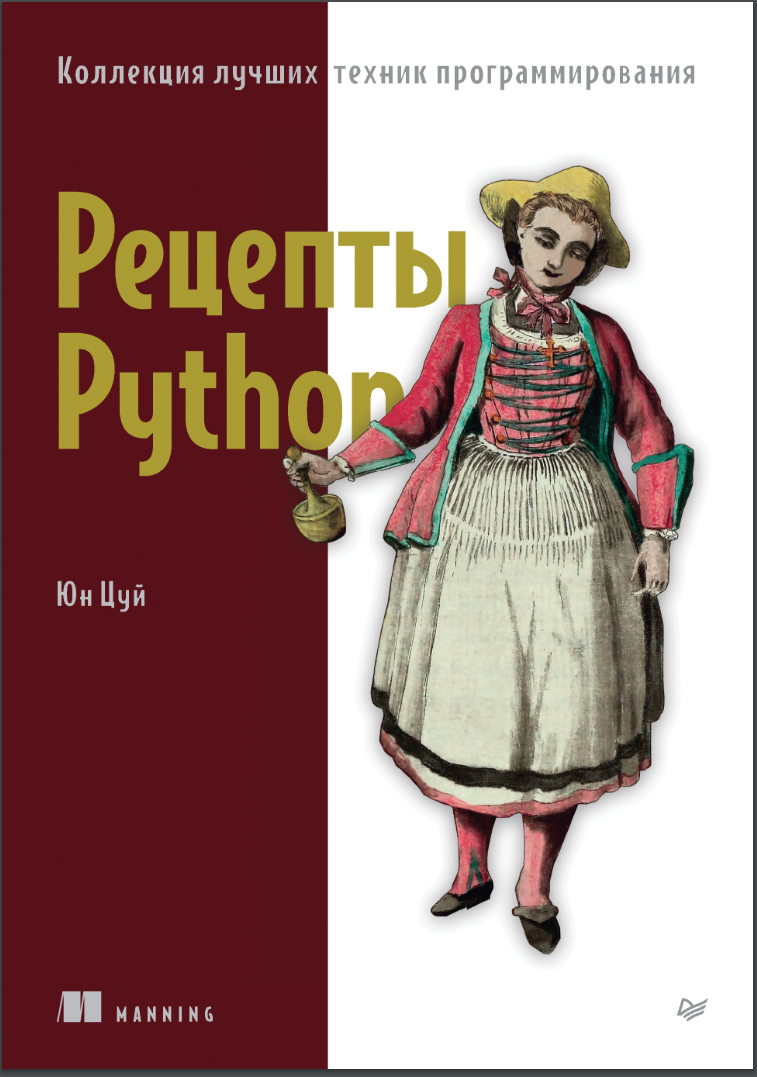
Рецепты Python. Коллекция лучших техник программирования - Цуй Юн
В «Рецептах Python» используется простой, но эффективный метод освоения 63-х базовых навыков программирования на Python. Сначала формулируется вопрос, например «Как найти элементы в последовательности?» Затем приводится базовое решение на чистом понятном коде. Далее исследуются другие интересные подходы, такие как поиск подстрок или пользовательские классы. Перед переходом к следующему вопросу полученные навыки закрепляются с помощью решения задач.
Автор рассматривает все языковые средства, необходимые для уверенного владения Python. По ходу знакомства с книгой вы изучите лучшие приемы написания питонического кода. В освоении каждого инструмента помогут конкретные рекомендации и рисунки. Многочисленные перекрестные ссылки указывают на возможность повторного использования рассматриваемых средств и концепций в различных контекстах.
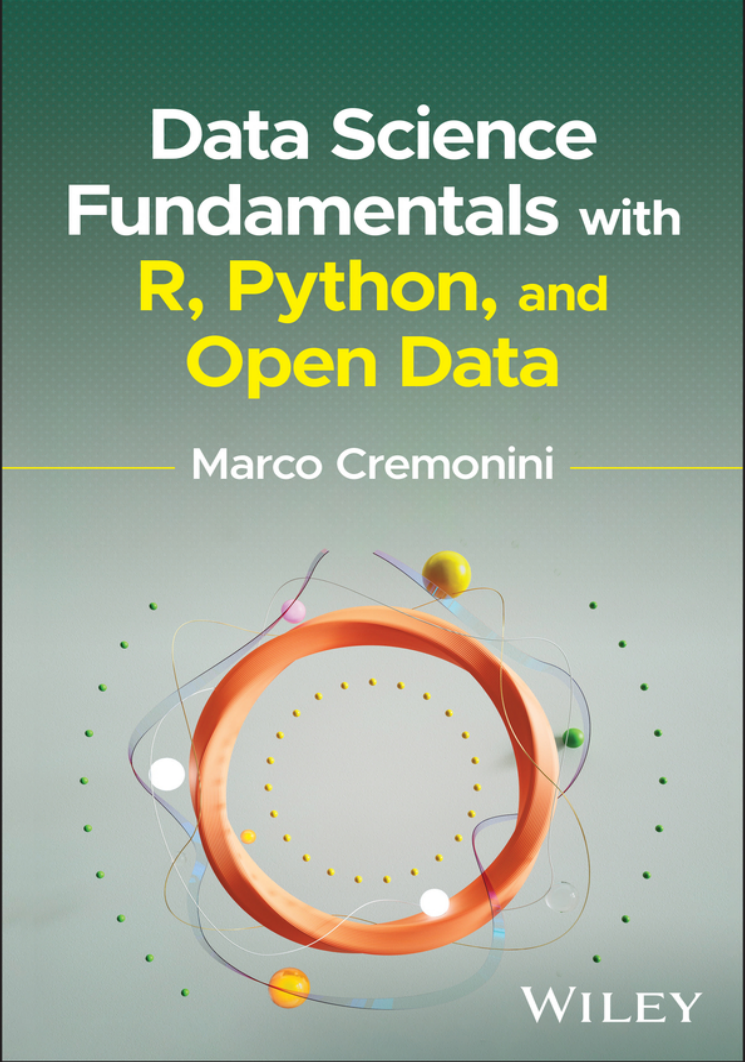
Data Science Fundamentals with R, Python, and Open Data - Marco Cremonini
Organized with a strong focus on open data, Data Science Fundamentals with R, Python, and Open Data discusses concepts, techniques, tools, and first steps to carry out data science projects, with a focus on Python and RStudio, reflecting a clear industry trend emerging towards the integration of the two. The text examines intricacies and inconsistencies often found in real data, explaining how to recognize them and guiding readers through possible solutions, and enables readers to handle real data confidently and apply transformations to reorganize, indexing, aggregate, and elaborate.
This book is full of reader interactivity, with a companion website hosting supplementary material including datasets used in the examples and complete running code (R scripts and Jupyter notebooks) of all examples. Exam-style questions are implemented and multiple choice questions to support the readers’ active learning. Each chapter presents one or more case studies.
Written by a highly qualified academic, Data Science Fundamentals with R, Python, and Open Data discuss sample topics such as:
- Data organization and operations on data frames, covering reading CSV dataset and common errors, and slicing, creating, and deleting columns in R
- Logical conditions and row selection, covering selection of rows with logical condition and operations on dates, strings, and missing values
- Pivoting operations and wide form-long form transformations, indexing by groups with multiple variables, and indexing by group and aggregations
- Conditional statements and iterations, multicolumn functions and operations, data frame joins, and handling data in list/dictionary format
Data Science Fundamentals with R, Python, and Open Data is a highly accessible learning resource for students from heterogeneous disciplines where Data Science and quantitative, computational methods are gaining popularity, along with hard sciences not closely related to computer science, and medical fields using stochastic and quantitative models.
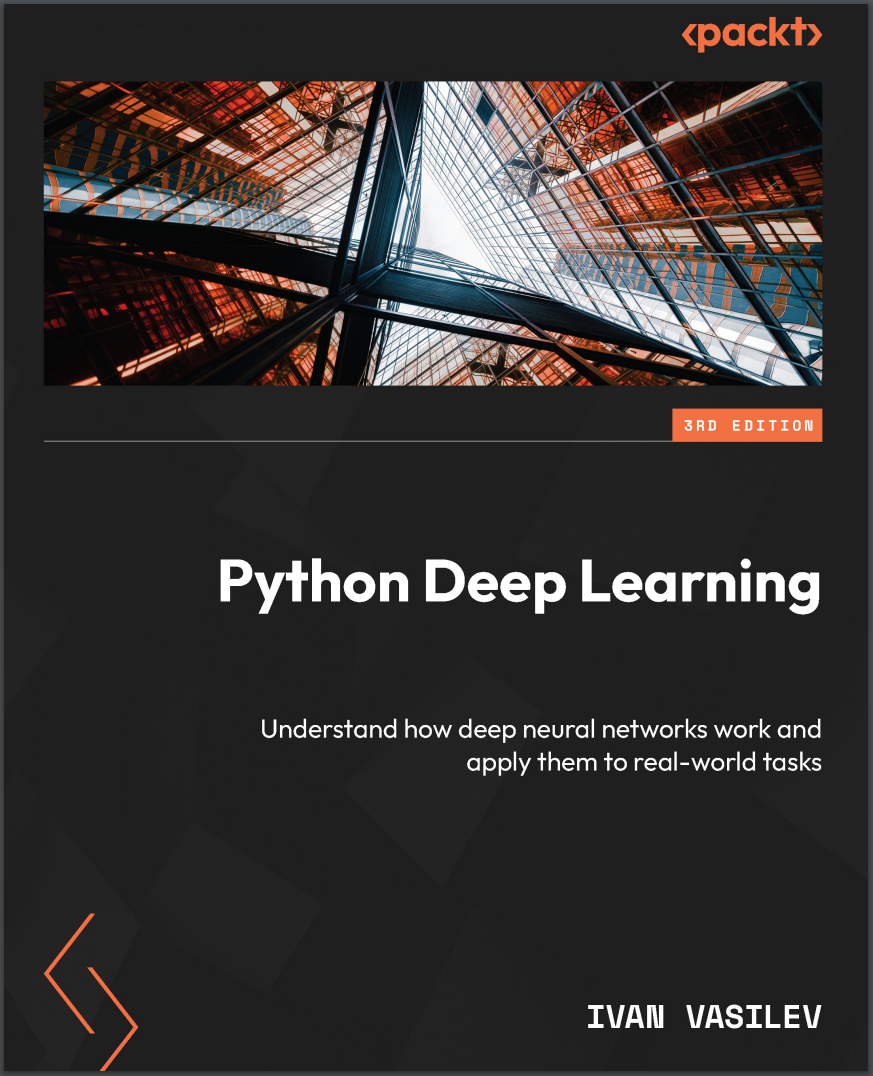
Python Deep Learning. 3 Ed - Ivan Vasilev
Master effective navigation of neural networks, including convolutions and transformers, to tackle computer vision and NLP tasks using Python
Key Features
- Understand the theory, mathematical foundations and the structure of deep neural networks
- Become familiar with transformers, large language models, and convolutional networks
- Learn how to apply them on various computer vision and natural language processing problems Purchase of the print or Kindle book includes a free PDF eBook
Book Description
The field of deep learning has developed rapidly in the past years and today covers broad range of applications. This makes it challenging to navigate and hard to understand without solid foundations. This book will guide you from the basics of neural networks to the state-of-the-art large language models in use today.
The first part of the book introduces the main machine learning concepts and paradigms. It covers the mathematical foundations, the structure, and the training algorithms of neural networks and dives into the essence of deep learning.
The second part of the book introduces convolutional networks for computer vision. We'll learn how to solve image classification, object detection, instance segmentation, and image generation tasks.
The third part focuses on the attention mechanism and transformers - the core network architecture of large language models. We'll discuss new types of advanced tasks, they can solve, such as chat bots and text-to-image generation.
By the end of this book, you'll have a thorough understanding of the inner workings of deep neural networks. You'll have the ability to develop new models or adapt existing ones to solve your tasks. You'll also have sufficient understanding to continue your research and stay up to date with the latest advancements in the field.
What you will learn
- Establish theoretical foundations of deep neural networks
- Understand convolutional networks and apply them in computer vision applications
- Become well versed with natural language processing and recurrent networks
- Explore the attention mechanism and transformers
- Apply transformers and large language models for natural language and computer vision
- Implement coding examples with PyTorch, Keras, and Hugging Face Transformers
- Use MLOps to develop and deploy neural network models
Who this book is for
This book is for software developers/engineers, students, data scientists, data analysts, machine learning engineers, statisticians, and anyone interested in deep learning. Prior experience with Python programming is a prerequisite.

A Simple Introduction to Python - Stephen Lynch
A Simple Introduction to Python is aimed at pre-university students and complete novices to programming. The whole book has been created using Jupyter notebooks. After introducing Python as a powerful calculator, simple programming constructs are covered, and the NumPy, MatPlotLib and SymPy modules (libraries) are introduced. Python is then used for Mathematics, Cryptography, Artificial Intelligence, Data Science and Object Oriented Programming.
The reader is shown how to program using the integrated development environments: Python IDLE, Spyder, Jupyter notebooks, and through cloud computing with Google Colab.
Features:
- No prior experience in programming is required.
- Demonstrates how to format Jupyter notebooks for publication on the Web.
- Full solutions to exercises are available as a Jupyter notebook on the Web.
- All Jupyter notebook solution files can be downloaded through GitHub.

Django for Professionals - William S. Vincent
Django for Professionals takes your web development skills to the next level, teaching you how to build production-ready websites with Python and Django.
Once you have learned the basics of Django there is a massive gap between building simple "toy apps" and what it takes to build a "production-ready" web application suitable for deployment to thousands or even millions of users.
In the book you’ll learn how to:
- Build a Bookstore website from scratch
- Use Docker and PostgreSQL locally to mimic production settings
- Implement advanced user registration with email
- Customize permissions to control user access
- Write comprehensive tests
- Adopt advanced security and performance improvements
- Add search and file/image uploads
- Deploy with confidence
If you want to take advantage of all that Django has to offer, Django for Professionals is a comprehensive best practices guide to building and deploying modern websites.

FastAPI: Modern Python Web Development - Bill Lubanovic
FastAPI is a young yet solid framework that takes advantage of newer Python features in a clean design. As its name implies, FastAPI is indeed fast, rivaling similar frameworks in languages such as Golang. With this practical book, developers familiar with Python will learn how FastAPI lets you accomplish more in less time with less code.
Author Bill Lubanovic covers the nuts and bolts of FastAPI development with how-to guides on various topics such as forms, database access, graphics, maps, and more that will take you beyond the basics. This book also includes how-to guides that will get you up to speed on RESTful APIs, data validation, authorization, and performance. With its similarities to frameworks like Flask and Django, you'll find it easy to get started with FastAPI.
Through the course of this book, you will:
- Learn how to build web applications with FastAPI
- Understand the differences between FastAPI, Starlette, and pydantic
- Learn two features that set FastAPI apart: asynchronous functions and data type checking and validation
- Examine new features of Python 3.8+, especially type annotations
- Understand the differences between sync and async Python
- Learn how to connect with external APIs and services

Python Graphics. 2 Ed - Bernard J. Korites
This book shows how to use Python’s built-in graphics primitives - points, lines, and arrows – to create complex graphics for the visualization of two- and three-dimensional objects, data sets, and technical illustrations.
This updated edition provides more detailed explanations where required, especially regarding Python code, and explores scientific applications to topics of contemporary importance. You’ll learn how to create any 2D or 3D object or illustration, as well as how to display images, use color, translate, rotate, shade, add shadows that are cast on other objects, remove hidden lines, plot 2D and 3D data, fit lines and curves to data sets, display points of intersection between 2D and 3D objects, and create digital art. Demonstrations are included which illustrate graphics programming techniques by example, the best way to learn a language.
Also brand new to this edition are demonstrations on how to visualize electron probability clouds around a nucleus, climate change, ecological diversity, population dynamics, and resource management. Python source code, including detailed explanations, is included for all applications, making the book more accessible to novice Python programmers.
After completing this book, you will be able to create compelling graphic images without being limited to functions available in existing Python libraries.
What You Will Learn
- Create 2D and 3D graphic images
- Add text and symbols to images
- Shade 3D objects
- Display cast shadows
- Use color for maximum effect
- View 2D and 3D data sets
- Fit lines and curves to data sets
Who This Book Is For
Python developers, scientists, engineers, and students who use Python to produce technical illustrations and display and analyze data sets. Assumes familiarity with vectors, matrices, geometry and trigonometry.
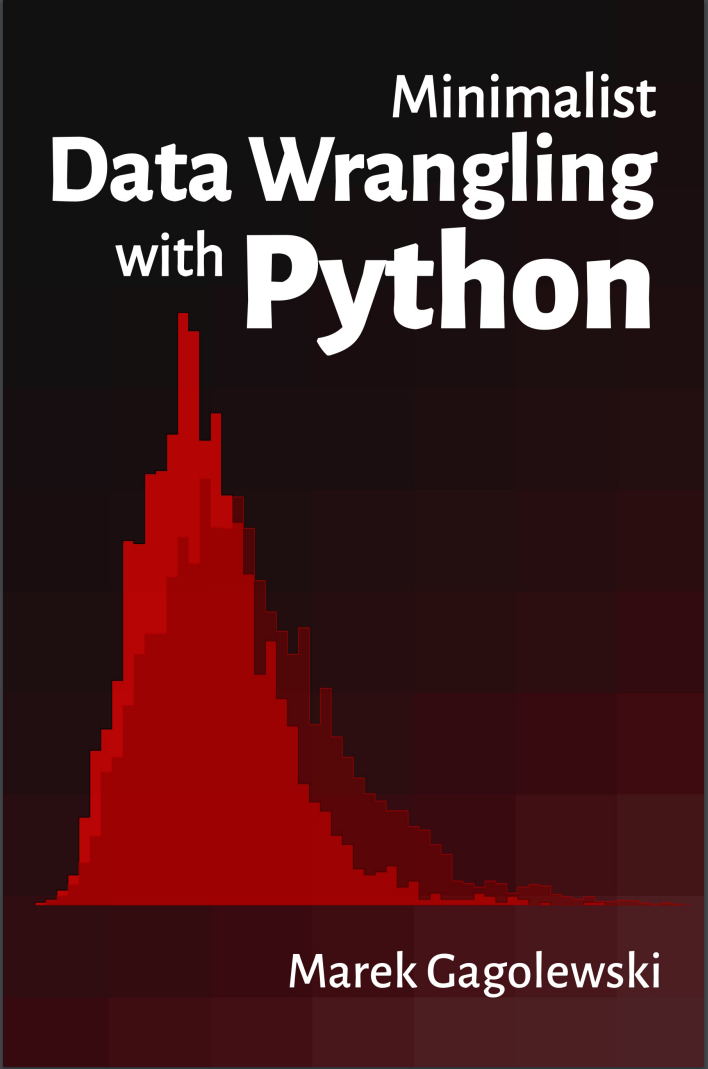
Minimalist Data Wrangling with Python - Marek Gagolewski
Minimalist Data Wrangling with Python is envisaged as a student's first introduction to data science, providing a high-level overview as well as discussing key concepts in detail. We explore methods for cleaning data gathered from different sources, transforming, selecting, and extracting features, performing exploratory data analysis and dimensionality reduction, identifying naturally occurring data clusters, modelling patterns in data, comparing data between groups, and reporting the results.
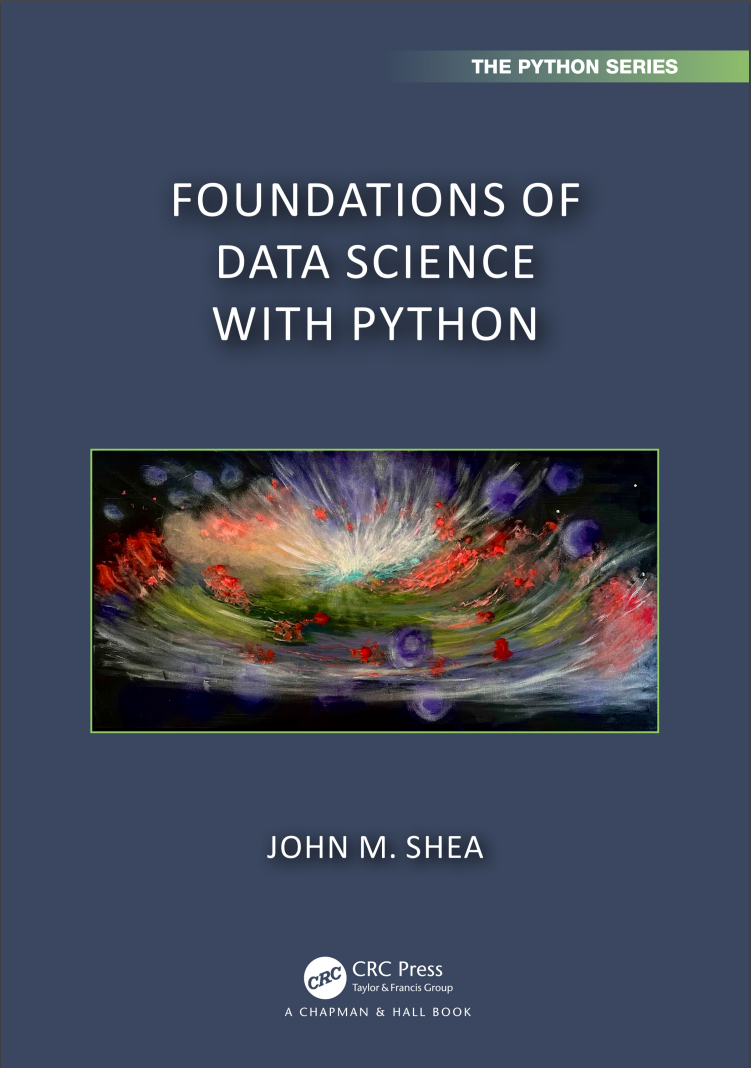
Foundations of Data Science with Python - John M. Shea
Foundations of Data Science with Python introduces readers to the fundamentals of data science, including data manipulation and visualization, probability, statistics, and dimensionality reduction. This book is targeted toward engineers and scientists, but it should be readily understandable to anyone who knows basic calculus and the essentials of computer programming. It uses a computational-first approach to data science: the reader will learn how to use Python and the associated data-science libraries to visualize, transform, and model data, as well as how to conduct statistical tests using real data sets. Rather than relying on obscure formulas that only apply to very specific statistical tests, this book teaches readers how to perform statistical tests via resampling; this is a simple and general approach to conducting statistical tests using simulations that draw samples from the data being analyzed. The statistical techniques and tools are explained and demonstrated using a diverse collection of data sets to conduct statistical tests related to contemporary topics, from the effects of socioeconomic factors on the spread of the COVID-19 virus to the impact of state laws on firearms mortality.
This book can be used as an undergraduate textbook for an Introduction to Data Science course or to provide a more contemporary approach in courses like Engineering Statistics. However, it is also intended to be accessible to practicing engineers and scientists who need to gain foundational knowledge of data science.
Key Features:
- Applies a modern, computational approach to working with data
- Uses real data sets to conduct statistical tests that address a diverse set of contemporary issues
- Teaches the fundamentals of some of the most important tools in the Python data-science stack
- Provides a basic, but rigorous, introduction to Probability and its application to Statistics
- Offers an accompanying website that provides a unique set of online, interactive tools to help the reader learn the material
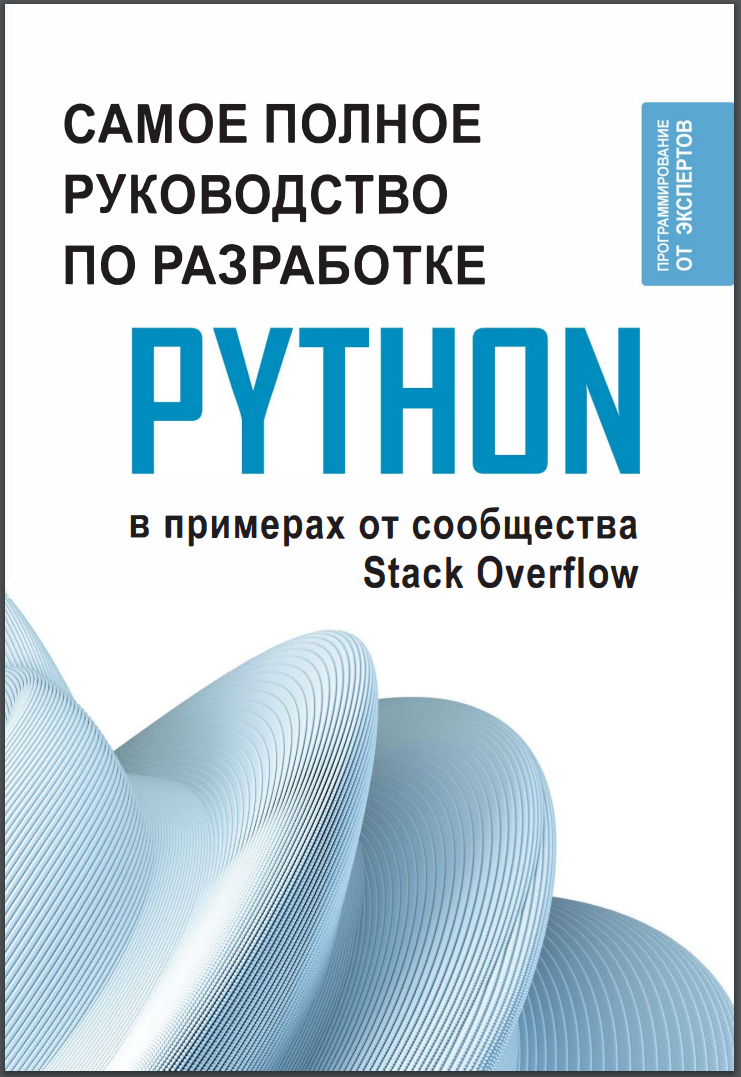
Самое полное руководство по разработке на Python - Коллектив авторов Stack Overflow
Данное руководство по программированию на одном из широко распространенных языков – Python – основано на практических примерах кодов, написанных специалистами и экспертами сообщества Stack Overflow, в котором лучшие разработчики программного обеспечения со всего мира делятся своими знаниями и опытом, отвечая на многие технические вопросы. Опытные Python-программисты найдут в книге множество примеров кода с подробными комментариями, что поможет им усовершенствовать свои навыки и достичь новых высот в отрасли. Однако данное издание будет полезно и начинающим специалистам с минимальным опытом и уровнем знаний, так как содержит исчерпывающее объяснение важнейших концепций Python с примерами, которые позволят избежать погружения в сухую теорию и помогут быстро повысить уровень своих компетенций. Читатели найдут здесь мощный и универсальный инструментарий для профессиональной работы в самых разных областях применения: с базами данных, веб-фреймворком Flask, XML и JSON, звуковыми данными, синтаксическим анализатором Lex-Yacc, а также при сетевом программировании, визуализации данных, многопоточности и многопроцессорности, программировании «интернета вещей». Кроме того, в книге представлена информация о применении Python в сфере науки, например, в математике, химии и криптографии. Отдельные главы посвящены секретам повышения скорости работы Python-кода и оптимизирования его производительности.

Миссия: Python. Создаем игры вместе с детьми - Шон МакМанус
Добро пожаловать в увлекательное космическое путешествие по просторам бескрайней Вселенной! У каждого космонавта есть своя миссия, а у юного читателя этой книги миссия особенная – создать свою первую игру на языке Python. В этом ему помогут подробные инструкции от автора, пошаговые иллюстрации и пул полезных советов. В конце каждой главы вас ждут практические упражнения для закрепления материала, а в конце книги – образцовые фрагменты кода и алгоритмы удаления самых распространенных багов. И все это в формате больших космических приключений, где главный герой – это вы!
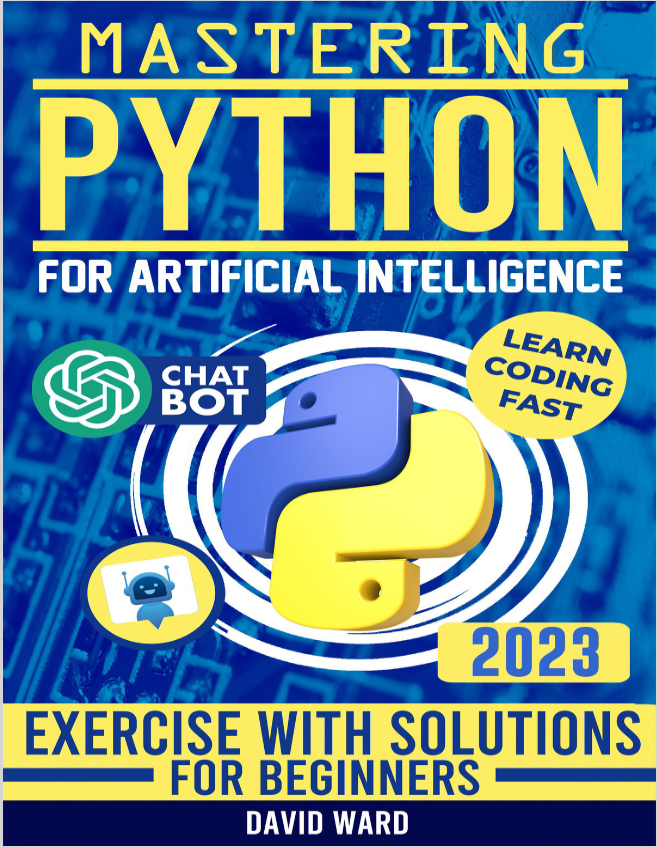
Mastering Python for Artificial Intelligence - David Ward
Look no further! "Mastering Python for Artificial Intelligence" is your gateway to learning the essential coding skills that will empower you to build cutting-edge AI applications.
Whether you're a beginner or an experienced programmer, this book will guide you through Python's intricacies and equip you with the knowledge to unleash the true potential of AI.
Mastering Python for Artificial Intelligence" offers an innovative approach encompassing three well-defined principles, ensuring an empowering learning journey for readers.
1. Practicality: The book strongly believes in the value of learning by doing. Unlike many other resources, "Mastering Python for Artificial Intelligence" immediately provides the outputs of ALL the examples. Readers won't have to wait to test the code on their computers or wonder if they are on the right track. This practical approach ensures hands-on experience, reinforcing knowledge and boosting confidence.
2. Simplicity: Learning complex subjects should be approached step by step, and "Mastering Python for Artificial Intelligence" embraces this principle. Each concept is broken down into simple and easily digestible steps. The book aims to make learning efficient and enjoyable, allowing readers to grasp a multitude of topics in the shortest possible time. Clear explanations and examples accompany the content, ensuring rapid progress and understanding.
3. Synthesis: Recognizing that starting with Python can be overwhelming, this book takes a thoughtful approach. Carefully selected topics provide a comprehensive introduction to Python, offering a solid foundation without overwhelming the reader. By presenting essential concepts in a structured manner, the book ensures broad exposure to Python and its applications in Artificial Intelligence.
Here's a sneak peek into what you'll discover:
- Gain a solid understanding of Python's notable features and why it is the preferred language for AI development.
- Learn the step-by-step process of Python IDE installation, ensuring you have the optimal environment for AI programming.
- Explore Python programming fundamentals, including variables, statements, operators, and flow control, laying the groundwork for AI development.
- Dive into the world of data types, such as numeric, sequence, string, list, tuple, set, and dictionary, and understand how they play a crucial role in AI applications.
- Unleash the potential of Python classes and objects and understand how they form the building blocks of AI models and algorithms.
- Discover the wealth of Python libraries and frameworks available for AI development, such as TensorFlow, Keras, scikit-learn, and more.
- Learn how to preprocess data, train AI models, and evaluate their performance using Python's powerful AI libraries.
- Get hands-on experience with practical coding examples and exercises, allowing you to apply your newfound knowledge and solidify your skills.
- The SOLUTIONS to the exercises (but be sure to look at them only after first trying to solve the exercises on your own)
- BONUS: EMPOWERING YOUR LIFE: Harnessing the Power of Chat GPT and Python to Create Your Personal Assistant (scan the QR code inside the book)
- …and much, much more!

Practical Discrete Mathematics - Archana Tikayat Ray, Ryan T. White
Discrete mathematics deals with studying countable, distinct elements, and its principles are widely used in building algorithms for computer science and data science. The knowledge of discrete math concepts will help you understand the algorithms, binary, and general mathematics that sit at the core of data-driven tasks.
Practical Discrete Mathematics is a comprehensive introduction for those who are new to the mathematics of countable objects. This book will help you get up to speed with using discrete math principles to take your computer science skills to a more advanced level.
As you learn the language of discrete mathematics, you'll also cover methods crucial to studying and describing computer science and machine learning objects and algorithms. The chapters that follow will guide you through how memory and CPUs work. In addition to this, you'll understand how to analyze data for useful patterns, before finally exploring how to apply math concepts in network routing, web searching, and data science.
By the end of this book, you'll have a deeper understanding of discrete math and its applications in computer science, and be ready to work on real-world algorithm development and machine learning.
What you will learn
- Understand the terminology and methods in discrete math and their usage in algorithms and data problems
- Use Boolean algebra in formal logic and elementary control structures
- Implement combinatorics to measure computational complexity and manage memory allocation
- Use random variables, calculate descriptive statistics, and find average-case computational complexity
- Solve graph problems involved in routing, pathfinding, and graph searches, such as depth-first search
- Perform ML tasks such as data visualization, regression, and dimensionality reduction
Who this book is for
This book is for computer scientists looking to expand their knowledge of discrete math, the core topic of their field. University students looking to get hands-on with computer science, mathematics, statistics, engineering, or related disciplines will also find this book useful. Basic Python programming skills and knowledge of elementary real-number algebra are required to get started with this book.